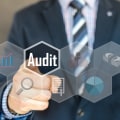Financial statement auditing is an essential component of any business, providing assurance that the financial records accurately reflect the company's financial position. As such, it is essential for organizations to be familiar with the standards and best practices for operational auditing. This article will provide a comprehensive overview of auditing standards for financial statements, helping organizations gain a better understanding of how to ensure their financial statements comply with the most up-to-date regulations. Through a discussion of best practices and guidelines, as well as practical examples and suggestions, this article will provide a comprehensive guide to auditing standards for financial statements.
Guidelines and Best Practices for Operational Auditing
Operational auditing is a key part of the financial statement audit process.It is the process of testing and evaluating the reliability, accuracy and completeness of financial statement information. In order to ensure that financial statements are accurate and reliable, auditors must use a variety of techniques, such as sampling, data analysis, and risk assessment. Sampling involves selecting a representative sample from a larger population. This allows auditors to test a small amount of the data to determine if there are any discrepancies or errors that could affect the entire population.
Data analysis allows auditors to identify trends and patterns in the data that can indicate potential issues with the accuracy of the financial statements. Risk assessment involves assessing the likelihood and impact of potential risks that could affect the financial statements. When conducting operational auditing, it is important to have a thorough understanding of the organization's internal controls and processes. Auditors should also be aware of any industry standards or laws that could impact the financial statements.
By using these techniques, auditors can ensure that financial statements are accurate and reliable.
Roles in Financial Statement Audits
Financial statement audits involve various parties, each of which plays an important role in the audit process. The primary roles are that of the auditor, the client, and other stakeholders. The auditor is responsible for conducting the audit, assessing the financial statements, and expressing an opinion on the financial position of the company.The auditor must ensure that all relevant information is obtained, that all applicable auditing standards have been complied with, and that any necessary adjustments have been made to the financial statements. The client is responsible for providing access to all relevant records, documents, and other information necessary for the auditor to perform their duties. The client also has the responsibility to provide accurate and complete financial statements and other information that can be used to support the financial statements. Other stakeholders may include creditors, investors, regulators, and other third parties who may be affected by the financial statements.
These stakeholders need to be informed of any changes or significant decisions that may affect their interests. It is important for all parties involved in a financial statement audit to understand their roles and responsibilities. This will help ensure that the audit process is conducted in a timely and effective manner and that accurate information is provided to all stakeholders.
Conducting a Financial Statement Audit
Conducting a financial statement audit is an important step in the auditing process. It involves the review of documents, identification of errors or discrepancies, analysis of data, assessment of internal controls, and testing for compliance with laws and regulations. The purpose of the audit is to provide assurance that the financial statements present a true and fair view of the company’s financial position. When reviewing documents, auditors will use analytical procedures to identify potential issues and errors.This includes examining the accuracy of account balances, comparing results with prior periods, and analyzing trends in financial performance. Auditors also review internal control procedures to ensure they are adequate and effective. In addition to reviewing documents, auditors must identify errors or discrepancies in the financial statements. This includes assessing whether transactions are properly recorded and if any information is missing or incorrect. Auditors must also analyze data to determine whether the financial statements are free from material misstatements. The next step in the process is to assess the internal controls.
This includes evaluating management’s ability to prevent fraud, assessing the effectiveness of accounting systems, and determining whether the company’s internal control environment is adequate. Auditors must also test for compliance with laws and regulations to ensure that the financial statements comply with relevant standards. Finally, auditors must prepare a report that details their findings and conclusions. The report should include recommendations for improving internal controls and procedures. Auditors must also evaluate the risk associated with any potential misstatements and provide an opinion as to whether the financial statements present a true and fair view of the company’s financial position.
Preparing for a Financial Statement Audit
Preparing for a financial statement audit is an important step to ensure that all necessary information is available to the auditor.It requires planning and foresight to ensure that all documents and records are organized and readily accessible. The following steps should be taken before beginning the audit:Gather Financial Records: The first step in preparation is to gather all financial records, including income statements, balance sheets, cash flow statements, and other relevant documents. Auditors need to review these documents in order to properly assess the financial health of the organization.
Organize Records:
Once all documents have been collected, it is important to organize them in a way that makes them easy to access during the audit. This includes keeping records in chronological order, labeling documents clearly, and filing them in a logical manner.Identify Business Activities:
Auditors also need to have a clear understanding of the business activities being conducted by the organization.This includes understanding the company’s products and services, customer base, and geographic scope of operations. This information will help the auditor assess the accuracy of the financial statements.
Analyze Historical Performance:
Auditors must also analyze historical performance in order to identify any potential problems or areas of concern. This includes reviewing past financial statements, analyzing trends in profits and losses, and examining any changes in the company’s operations.Communicate with Management:
Finally, it is important to communicate with management prior to beginning the audit. This ensures that all parties understand the expectations of the audit process and can provide any additional information needed by the auditor.Reporting After an Audit
The purpose of preparing a report after an audit is to clearly communicate the results of the audit and provide recommendations for improving processes or controls.This report should include an analysis of the company's internal controls, financial statements, and other financial data. It should also include the auditor's opinion on the fairness of the financial statements and any recommendations for improvement. The report should be written in a clear and concise manner so that it is easily understood by management and other stakeholders. When preparing a report after an audit, the auditor should provide an executive summary that includes a brief overview of the audit findings. This should include a summary of the major areas of concern and any significant issues identified during the audit process.
The auditor should then provide detailed explanations of each of the major findings, including a discussion of any areas that require further investigation or changes to processes or controls. In addition, the report should include any recommendations for improving processes or controls that may be necessary to ensure future compliance with applicable laws and regulations. When preparing a report after an audit, the auditor should also provide a statement of opinion about the company's internal controls, financial statements, and other financial data. This statement should include an opinion on whether or not the company has adequate internal controls and is able to produce reliable financial statements. The opinion should also include any recommendations for improvement that may be necessary to ensure future compliance with applicable laws and regulations. Finally, when preparing a report after an audit, the auditor should provide a conclusion that summarizes the results of the audit.
The conclusion should include a discussion of any areas that require further investigation or changes to processes or controls. It should also include any recommendations for improvement that may be necessary to ensure future compliance with applicable laws and regulations. In conclusion, this article has discussed the importance of adhering to standards for financial statement auditing. It has explored the roles of various parties involved in financial statement audits, provided details on how to prepare for a financial statement audit, outlined specific steps that should be taken during a financial statement audit, highlighted guidelines and best practices for operational auditing, and explained the reporting process after a financial statement audit is completed. Adhering to these standards and guidelines will ensure that financial statement audits are thorough, accurate, and effective.







